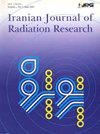Effects of different doses of X-ray radiation on nerve regeneration after sciatic nerve injury in a rat model
Q4 Health Professions
引用次数: 0
Abstract
Background: Physical agents, such as ultrasound, can promote functional restoration and regenerative processes of the peripheral nervous system. However, little is known about the effects of X-ray radiation on nerve regeneration after peripheral nerve injury. The aim of the present study was to investigate the effects of various doses of X-ray radiation on nerve regeneration after sciatic nerve injury in rats. Materials and Methods: The sciatic nerves of Sprague-Dawley rats were transected and repaired via epineurium end-to-end neurorrhaphy. Eighty rats each received single and local X-ray doses of 0 Gy, 0.2 Gy, 1 Gy, 7 Gy and 14 Gy. Functional and morphological assessments of the process of nerve regeneration were performed by using various measurement tools. Results: Compared with the 0 Gy, 0.2 Gy and 14 Gy groups, the 1 Gy and 7 Gy radiation groups experienced significantly increased sciatic functional index, motor nerve conductive velocity (MNCV), expression of S-100, mean diameter of axons, and thickness of myelin sheaths and decreased perineural scar tissue. There were no differences between the 1 Gy group and the 7 Gy group or between the 0 Gy group, the 0.2 Gy group and the 14 Gy group with the exception of MNCV and the expression level of S-100. Conclusion: X-ray radiation in doses of 1 Gy and 7 Gy promoted nerve regeneration after sciatic nerve injury in a rat model. The dose of 14 Gy exerted inhibitory effects, and 0.2 Gy exerted no significant effect on nerve regeneration.不同剂量X射线照射对大鼠坐骨神经损伤后神经再生的影响
背景:超声等物理因素可以促进周围神经系统的功能恢复和再生过程。然而,关于x射线辐射对周围神经损伤后神经再生的影响,目前知之甚少。本研究旨在探讨不同剂量x射线辐射对大鼠坐骨神经损伤后神经再生的影响。材料与方法:横断大鼠坐骨神经,经神经外膜端到端缝合修复。80只大鼠分别接受0 Gy、0.2 Gy、1 Gy、7 Gy和14 Gy的单次和局部x射线剂量。使用各种测量工具对神经再生过程进行功能和形态学评估。结果:与0 Gy、0.2 Gy和14 Gy组比较,1 Gy和7 Gy组坐骨功能指数、运动神经传导速度(MNCV)、S-100表达、轴突平均直径、髓鞘厚度显著升高,神经周围瘢痕组织显著减少。1 Gy组与7 Gy组、0 Gy组与0.2 Gy组与14 Gy组间除MNCV和S-100表达水平差异外,无显著性差异。结论:1 Gy和7 Gy剂量的x线辐射可促进大鼠坐骨神经损伤后的神经再生。14 Gy对神经再生有抑制作用,0.2 Gy对神经再生无明显影响。
本文章由计算机程序翻译,如有差异,请以英文原文为准。
求助全文
约1分钟内获得全文
求助全文
来源期刊

Iranian Journal of Radiation Research
RADIOLOGY, NUCLEAR MEDICINE & MEDICAL IMAGING-
CiteScore
0.67
自引率
0.00%
发文量
0
审稿时长
>12 weeks
期刊介绍:
Iranian Journal of Radiation Research (IJRR) publishes original scientific research and clinical investigations related to radiation oncology, radiation biology, and Medical and health physics. The clinical studies submitted for publication include experimental studies of combined modality treatment, especially chemoradiotherapy approaches, and relevant innovations in hyperthermia, brachytherapy, high LET irradiation, nuclear medicine, dosimetry, tumor imaging, radiation treatment planning, radiosensitizers, and radioprotectors. All manuscripts must pass stringent peer-review and only papers that are rated of high scientific quality are accepted.
 求助内容:
求助内容: 应助结果提醒方式:
应助结果提醒方式:


